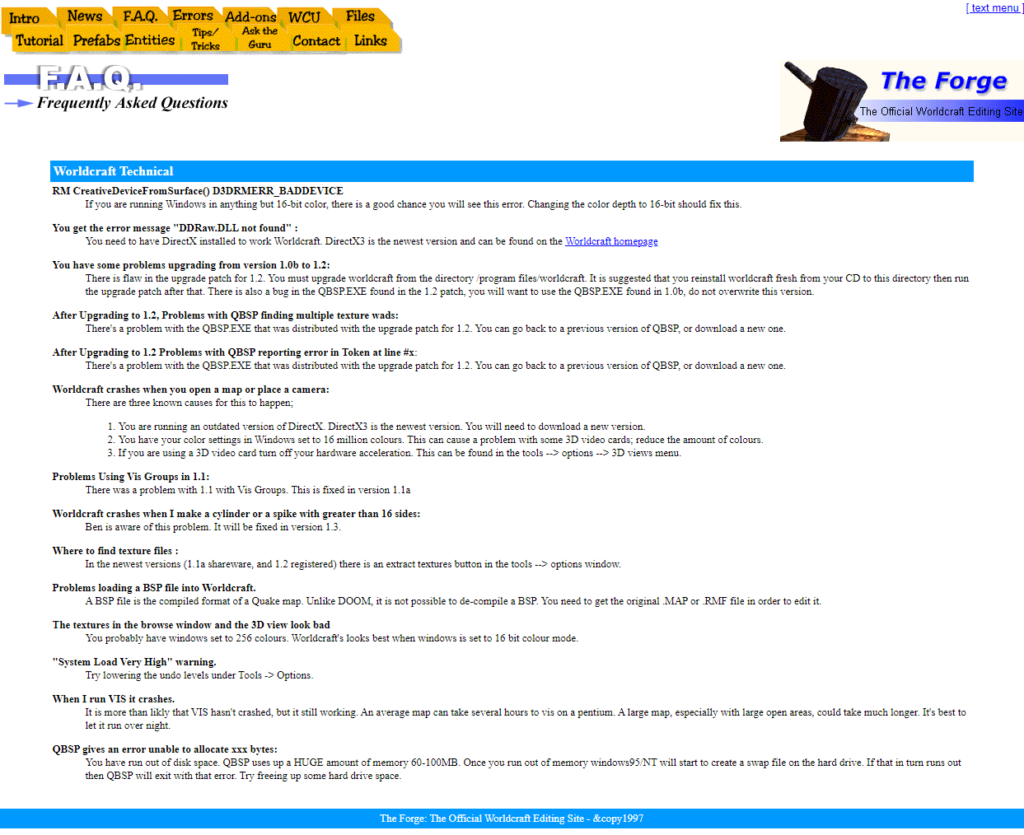On Website Restoration
- Posted by mariteaux on September 2nd, 2020 filed in Strong Opinions
- Comment now »
So happy September, lads. Sudden major mood boost last night and now I’m 500something words into a new story for Pinede. Pretty stoked.
I don’t really do the unsolicited opinion posts anymore, not unless something sets it off and not unless it’s something I feel someone could potentially have a discussion with me on. Course, it being my Scratchpad and the biggest fan of the Scratchpad being me, who am I to disappoint? So given that it’s not quite bedtime and yet a bit too late to get cracking on anything heavy (trying not to stay up into the wee small hours of the night anymore), here’s something I’ve been thinking about lately: website mirrors and what level of restoration is worthwhile from a preservation standpoint.
Yesterday’s post was on the restoration of an old website called The Forge. I got my working copy from someone else’s mirror, though the mirror seems to otherwise unaltered from the Wayback Machine’s copy, so I’m fairly certain it’s accurate as far as source goes. Still, as with most old sites, The Forge doesn’t look quite right on modern monitors, and it’s to do with width. Check it out on my screen, unaltered:

Back in 1997, 800×600 was considered a high-res desktop resolution, and sites were still being commonly built for 640px. The Forge sets its tables to two widths, generally: 600px, which still looks fine of course, and 90%, which doesn’t. At the time, 90% of 800px would’ve been a comfortable reading experience with margins on both sides, given that it’s centered; now, it’s just way too wide, proving both irritating to read and inaccurate to how the site would’ve been viewed in 1997.
This raises an interesting question: what is “accurate” as far as web pages go? Is it uncompromised markup with rendering errors on the viewer’s end, or is it inaccurate markup with widths constrained to more period-appropriate (not to mention more comfortable) values? I lean towards the latter. The intended experience is the finished site loaded in the browser as a layout, text, and images, not as a page of unrendered markup. Thus, while a constrained width is inaccurate, the viewing experience is better and closer to what was intended.
Of course, things will never be completely accurate because web pages are not an absolute canvas. Pages will render completely differently on different generations of browsers, both newer and older than the contemporary ones. Even contemporary ones differ: if Internet Explorer renders its inline audio players in such a way that the layout ends up warped, it’s certainly visually inaccurate even though the same source page is being rendered. There’s too many variables at play, too much error from too many humans, to say anything is exact. Total accuracy will never be achieved because there never was a completely accurate way to look at this site.
Of course, a true preservationist would probably say any edits at all to the source material compromise the integrity of it. While I’d agree, I’d also put forth the following point: the Wayback Machine, formerly the gold standard of archival sites before it fell to political mischief, does not perfectly preserve pages. Look at the page source of anything it’s saved: it adds tracking scripts and explicitly modifies the page’s visuals to messily insert the toolbar it uses for navigation. Even if this is simply a server-side runtime script and the original pages are perfectly preserved, to the viewer, the page has been compromised.
<!DOCTYPE HTML PUBLIC "-//W3C//DTD HTML 3.2//EN">
<html>
<head><script src="//archive.org/includes/analytics.js?v=cf34f82" type="text/javascript"></script>
<script type="text/javascript">window.addEventListener('DOMContentLoaded',function(){var v=archive_analytics.values;v.service='wb';v.server_name='wwwb-app39.us.archive.org';v.server_ms=359;archive_analytics.send_pageview({});});</script><script type="text/javascript" src="/_static/js/playback.bundle.js?v=fdAPlHIS" charset="utf-8"></script>
<script type="text/javascript" src="/_static/js/wombat.js?v=cRqOKCOw" charset="utf-8"></script>
<script type="text/javascript">
__wm.init("http://web.archive.org/web");
__wm.wombat("http://www.planetquake.com:80/worldcraft/prelim/","19981202145014","http://web.archive.org/web/","web","/_static/",
"912610214","www.planetquake.com:80");
</script>
<link rel="stylesheet" type="text/css" href="/_static/css/banner-styles.css?v=NHuXCfBH" />
<link rel="stylesheet" type="text/css" href="/_static/css/iconochive.css?v=qtvMKcIJ" />
<!-- End Wayback Rewrite JS Include -->
<title>Preliminary Findings: Worldcraft 1.6</title>
</head>
<body background="/web/19981202145014im_/http://www.planetquake.com/worldcraft/prelim/gfx/ceramic.gif" bgcolor="#000000" text="#C0C0C0" link="#FFFFFF" vlink="#FFFFFF" alink="#008080"><!-- BEGIN WAYBACK TOOLBAR INSERT -->What is the difference between the Wayback Machine doing this and a human doing this? Both humans are robots are capable of malevolently editing pages, if that’s the concern. If anything, robots are capable of far more damage. Even saving a page to your computer as “complete” changes the links to refer to the local copy and not the ones online. Nothing perfectly preserves site markup. Therefore, I say it’s fair game.
I did go a little further than that, however. Given that my operating assumption is that the intent of the site developer is what matters and not what’s actually on the page, I fixed a variety of bugs in the original site’s markup. Some involved the layout of the page itself; if you look at the March 1998 news page on the original mirror, you can see it’s really broken. I straightened it out a little on my mirror. Any scripts and ads relating to GameSpy got removed (because they don’t work anyway anymore). Broken esoteric symbols (“Zerstörer”, “Jim Dosé”, the copyright symbol, etc) got patched, as the original site didn’t specify character encoding and the mirror therefore saved wrong. I also ran HTML-Tidy over many of the pages I didn’t patch by hand, and those I did, I practically rewrote by hand to make them as readable as possible.
Now, the one area I do draw the line in is rewriting pages that originally didn’t use stylesheets to use them. Back when The Forge was written, stylesheet support was nonexistent or just barely supported in some browsers; thus, it doesn’t use one. Since using a stylesheet would therefore compromise how the page renders on these older browsers (and again, I’m going off intent and visual accuracy), I opted not to add one. This also extends to the many links on the site that use JavaScript to set the status bar; modern browsers ignore it and simply display the link URL instead. Minor detail, but given that older browsers obviously still support it (plus browsers forked from their code, like RetroZilla), I left it in.
I think there’d be a lot of people who would ask me what point there is in restoring an old website that not even the people behind it have thought about in 20 years. To be perfectly honest, I don’t really have a point. It’s really just something that pleases me. That said, the one place I can objectively justify a site restoration is when content’s been lost or gone missing from a mirror. My entire reason for doing this was that The Forge’s file downloads were never stored with the site itself, and while they thankfully survived, they weren’t in their proper context on an FTP server. Merging the two only makes sense.
And since I was already working on that, I figured I might as well clean the visuals up as a labor of love…
…and that’s how you end up with a mirror like mine. It’s a curiosity, one of a few on my radar. If they’ll get the same love and care or if I’ll just run Tidy over them, I’ll have to see. Point or not, it’s nice to bring little historical relics like this back from the brink, and like VDU itself, the content’s safe with me now. I’m sure at least someone in the old web crowd would appreciate it.
